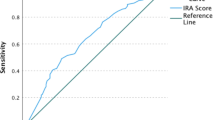Abstract
Antiretroviral therapy (ART) requires lifelong daily oral therapy. While patient characteristics associated with suboptimal ART adherence and persistence have been described in cohorts of HIV-infected persons, these factors are poor predictors of individual medication taking behaviors. We aimed to create and test instruments for the estimation of future ART adherence and persistence for clinical and research applications. Following formative work, a battery of 148 items broadly related to HIV infection and treatment was developed and administered to 181 HIV-infected patients. ART adherence and persistence were assessed using electronic monitoring for 3 months. Perceived confidence in medication taking and self-reported barriers to adherence were strongest in predicting non-adherence over time. Barriers to adherence (e.g., affordability, scheduling) were the strongest predictors of non-adherence, as well as 3- and 7-day non-persistence. A ten-item battery for prediction of these outcomes (www.med.unc.edu/ncaidstraining/adherence/for-providers) and a 30-item battery reflective of underlying psychological constructs can help identify and study individuals at risk for suboptimal ART adherence and persistence.
Similar content being viewed by others
References
Thompson MA, Mugavero MJ, Amico KR, et al. Guidelines for improving entry into and retention in care and antiretroviral adherence for persons with HIV: evidence-based recommendations from an international association of physicians in AIDS care panel. Ann Intern Med. 2012;156(11):817–33.
Mugavero MJ, Davila JA, Nevin CR, Giordano TP. From access to engagement: measuring retention in outpatient HIV clinical care. AIDS Patient Care STDS. 2010;24(10):607–13.
Rudy BJ, Murphy DA, Harris DR, Muenz L, Ellen J. Patient-related risks for nonadherence to antiretroviral therapy among HIV-infected youth in the United States: a study of prevalence and interactions. AIDS Patient Care STDS. 2009;23(3):185–94.
Nachega JB, Parienti JJ, Uthman OA, et al. Lower pill burden and once-daily antiretroviral treatment regimens for HIV infection: a meta-analysis of randomized controlled trials. Clin Infect Dis. 2014;58(9):1297–307.
Schneider J, Kaplan SH, Greenfield S, Li W, Wilson IB. Better physician-patient relationships are associated with higher reported adherence to antiretroviral therapy in patients with HIV infection. J Gen Intern Med. 2004;19(11):1096–103.
Halkitis PN, Shrem MT, Zade DD, Wilton L. The physical, emotional and interpersonal impact of HAART: exploring the realities of HIV seropositive individuals on combination therapy. J Health Psychol. 2005;10(3):345–58.
Stirratt MJ, Remien RH, Smith A, et al. The role of HIV serostatus disclosure in antiretroviral medication adherence. AIDS Behav. 2006;10(5):483–93.
Carr RL, Gramling LF. Stigma: a health barrier for women with HIV/AIDS. J Assoc Nurses AIDS Care. 2004;15(5):30–9.
Ryscavage P, Anderson EJ, Sutton SH, Reddy S, Taiwo B. Clinical outcomes of adolescents and young adults in adult HIV care. J Acquir Immune Defic Syndr. 2011;58(2):193–7.
Miller LG, Liu H, Hays RD, et al. How well do clinicians estimate patients’ adherence to combination antiretroviral therapy? J Gen Intern Med. 2002;17(1):1–11.
Muessig KE, Panter AT, Mouw MS, et al. Medication-taking practices of patients on antiretroviral hiv therapy: control, power, and intentionality. AIDS Patient Care STDS. 2015;29(11):606–16.
Wohl D, Jones S, Brown J, Panter AT, Maiese E. Barriers to medication adherence remain in the era of potent HIV therapy. Abstract 143. 8th International Conference on HIV treatment and prevention adherence. June 2–4, 2013, Miami, Florida.
Johnson MO, Neilands TB, Dilworth SE, Morin SF, Remien RH, Chesney MA. The role of self-efficacy in HIV treatment adherence: validation of the HIV treatment adherence self-efficacy scale (HIV-ASES). J Behav Med. 2007;30(5):359–70.
Chesney MA, Ickovics JR, Chambers DB, et al. Self-reported adherence to antiretroviral medications among participants in HIV clinical trials: the AACTG adherence instruments. AIDS Care. 2000;12(3):255–66.
Giordano T, Guzman D, Clark R, Charlebois E, Bangsberg D. Measuring adherence to antiretroviral therapy in a diverse population using a visual analogue scale. HIV Clin Trials. 2004;5(2):74–9.
Cai L, Thissen D, du Toit SHC. IRTPRO for Windows [Computer software]. Lincolnwood: Scientific Software International; 2011.
Friedman J, Hastie T, Tibshirani R. Regularization paths for generalized linear models via coordinate descent. J Stat Softw. 2010;33(1):1–22.
Acknowledgements
This study was supported by a research Grant from Merck & Co., Inc, and the University of North Carolina at Chapel Hill Center for AIDS Research (CFAR), an NIH funded program P30 AI50410. We are grateful to the many service providers and the staff at participating clinics who contributed and the many patients living with HIV infection who generously participated. We thank our dedicated ESTEEM research assistants: Madison Hayes, Katherine Stein, Joseph Murphy, Jazmin Brown, Shawn Jones, and Jasmine Stringer.
Author information
Authors and Affiliations
Corresponding author
Ethics declarations
Conflict of interest
The authors have no relevant conflicts of interest to report.
Ethical Approval
All procedures performed in studies involving human participants were in accordance with the ethical standards of the institutional and/or national research committee and with the 1964 Helsinki declaration and its later amendments or comparable ethical standards.
Informed Consent
Informed consent was obtained from all individual participants included in the study.
Electronic supplementary material
Below is the link to the electronic supplementary material.
Rights and permissions
About this article
Cite this article
Wohl, D.A., Panter, A.T., Kirby, C. et al. Estimating HIV Medication Adherence and Persistence: Two Instruments for Clinical and Research Use. AIDS Behav 22, 948–960 (2018). https://doi.org/10.1007/s10461-017-1772-z
Published:
Issue Date:
DOI: https://doi.org/10.1007/s10461-017-1772-z



